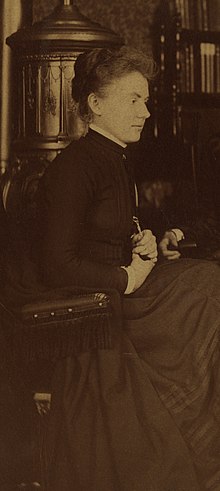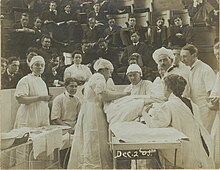Bertha Van Hoosen
Bertha Van Hoosen | |
|---|---|
 Dr. Bertha Van Hoosen | |
| Born | March 26, 1863 |
| Died | June 7, 1952 (aged 89) |
| Education | University of Michigan |
| Occupation | Surgeon |
Bertha Van Hoosen (March 26, 1863 – June 7, 1952) was an American surgeon devoted to women's health issues and the advancement of fellow women surgeons. Among other notable achievements, Van Hoosen was the first president and a founder of the American Medical Women's Association in 1915 and the first woman to be head of a medical division at a coeducational university.[1] She published an autobiography detailing her personal experiences in medicine, Petticoat Surgeon.[2]
Early life
[edit]Bertha Van Hoosen was born to parents Joshua Van Hoosen, a farmer, and Sarah Ann Taylor, a teacher, in Stony Creek, Michigan, in 1863.[3] She grew up on her parents' farm and attended high school in Pontiac, Michigan, graduating at the age of 17.[3][4] In order for Van Hoosen to attend high school, her father would drop her off in a horse-drawn wagon Monday morning and pick her up Friday nights at the conclusion of the school week.[5]
Education
[edit]Soon after graduation, Van Hoosen enrolled at the University of Michigan. During her undergraduate education she was drawn to the study of medicine, compelled by the opportunity to spend the rest of her life learning and advancing.[6] As such, upon receiving her Bachelor of Arts degree in the University of Michigan's literary study in 1884, Van Hoosen enrolled in the University of Michigan's medical department.[6][4][7]
Van Hoosen received almost no support in her pursuit of medical education. As her parents did not agree with her career choice and therefore would not fund her studies, she was tasked with paying her own tuition by working as an obstetrical nurse, an anatomy demonstrator, and a schoolteacher.[3][8]
Despite this challenge, compounded with frequent harassment from male students,[3] Van Hoosen graduated with a medical degree in 1888.[2] She accepted a series of three residencies – first at the Women's Hospital in Detroit, then in the Kalamazoo, Michigan, State Hospital for the Insane, and finally the New England Hospital for Women and Children in Boston – totaling four years of additional training.[4]
Career
[edit]
In 1892, with money saved from her previous jobs, Van Hoosen opened her own private clinic in Chicago, Illinois.[3] As the clinic grew, she taught anatomy and embryology at the Women's Medical School of Northwestern University and took a clinical assistantship at the Columbia Dispensary in Chicago, where she continued to learn about surgery and obstetrics.[4] Her practice flourished.
In 1902, despite opposition from male faculty she became a clinical gynecology professor at the Illinois University Medical School, a position she would hold for 10 years.[9]
In 1913, Van Hoosen became chief of the gynecological staff at Cook County Hospital in Chicago – the first woman to receive a civil service appointment at a hospital.[3] Not long after, in 1918, her work won the respect of male colleagues and earned her position as Acting Head and Professor of Obstetrics at Loyola University Medical School.[2][4]
Van Hoosen continued her private practice while serving as an attending physician at many Chicago hospitals.[4] She taught sex education, established a breast milk bank, and advocated for the use of scopolamine-morphine anesthesia for childbirth.[3] She also spoke against the medical establishment's discrimination against women and together with Marion Craig Potter founded the American Medical Women's Association in 1915.[4][3][10]

Throughout her career, Van Hoosen developed, illustrated, and promoted many medical techniques,[11] including the "buttonhole" appendectomy surgical technique, the use of scopolamine-morphine as an anesthetic,[12] and the emphasis on hygiene and sterilization of medical instruments to prevent infection. [13]
Travels
[edit]
As recounted in the documentary Pioneer Family on Van Hoosen Farm,[14] largely based on the account in Petticoat Surgeon, Van Hoosen was an extensive world traveler. In 1909 she used her first international convention in Budapest to start a year-long tour of Europe and parts of Africa. In 1929 she traveled via the Spanish liner Alfonso XIII with her sister Alice and was invited to Florence to meet with Pope Pius XII. In the year following the death of her mother, Bertha traveled with Alice and her niece Sarah via Honolulu to New Zealand, Australia and then to China and Japan. Their arrival in Japan coincided with the 1923 Great Kantō earthquake.
Legacy
[edit]The Bertha Van Hoosen Award is given annually by the American Medical Women's Association.[15] This award is given to a woman who has served the American Medical Women's Association greatly with their contributions.[15] To be given this award, a woman must be an active member in the American Medical Women's Association for a minimum of five years.[15]
Bertha Van Hoosen's name is still honored at the University of Michigan. The Van Hoosen House was dedicated in her honor at Bursley Hall.[16]
She was inducted into the Michigan Women's Hall of Fame in 1984.
References
[edit]- ^ More, Ellen S. (1989-01-01). ""A Certain Restless Ambition": Women Physicians and World War I". American Quarterly. 41 (4): 636–660. doi:10.2307/2713096. JSTOR 2713096. PMID 11616546.
- ^ a b c Sirridge, Marjorie (Fall 1996). "Daughters of Æsculapius: A Selected Bibliography of Autobiographies of Women Medical School Graduates 1849-1920". Literature and Medicine. 15 (2): 200–216. doi:10.1353/lm.1996.0027. PMID 8923437. S2CID 1382241. ProQuest 816420209.
- ^ a b c d e f g h McGovern, Constance M. (2000). "Van Hoosen, Bertha (1863-1952), surgeon". American National Biography Online. doi:10.1093/anb/9780198606697.article.1200934.
- ^ a b c d e f g "Changing The Face Of Medicine". nlm.nih.gov. Retrieved 3 March 2016.
- ^ "Bertha Van Hoosen". Living in History.
- ^ a b Chaff, Sandra (1978). "Bertha Van Hoosen 1863-1952". Women & Health. 3.
- ^ McGovern, Constance M. (1999). Van Hoosen, Bertha. Oxford University Press. doi:10.1093/anb/9780198606697.article.1200934.
- ^ "Virtual Exhibit Page 1". ww3.rochesterhills.org. Archived from the original on 2016-04-07. Retrieved 2016-03-22.
- ^ Drachman, Virginia G. (1982-01-01). "Female Solidarity and Professional Success: The Dilemma of Women Doctors in Late Nineteenth-Century America". Journal of Social History. 15 (4): 607–619. doi:10.1353/jsh/15.4.607. JSTOR 3787412. PMID 11632388.
- ^ Appel, Toby A. (2014-10-20). "Writing Women into Medical History in the 1930s: Kate Campbell Hurd-Mead and "Medical Women" of the Past and Present". Bulletin of the History of Medicine. 88 (3): 457–492. doi:10.1353/bhm.2014.0050. ISSN 1086-3176. PMID 25345770. S2CID 40271354.
- ^ Walsh, Mary Roth (1979-12-01). "The Rediscovery of the Need for a Feminist Medical Education". Harvard Educational Review. 49 (4): 447–466. doi:10.17763/haer.49.4.3220j044453t6509. ISSN 0017-8055. PMID 11614528.
- ^ Leavitt, Judith Walzer (1980-01-01). "Birthing and Anesthesia: The Debate over Twilight Sleep". Signs. 6 (1): 147–164. doi:10.1086/493783. JSTOR 3173972. PMID 21213656. S2CID 143270848.
- ^ Bertha Van Hoosen papers, 1913-1971, bulk 1920-1950. Drexel University College of Medicine, Legacy Center: Archives and Special Collections on Women in Medicine and Homeopathy. http://dla.library.upenn.edu/cocoon/dla/pacscl/ead.pdf?id=PACSCL_DUCOM_WMSC145
- ^ "Pioneer Family on Van Hoosen Farm". Detroit Public TV.
- ^ a b c "Bertha Van Hoosen". American Medical Women's Association. Retrieved 23 April 2019.
- ^ "Bertha Van Hoosen". Living in History.
